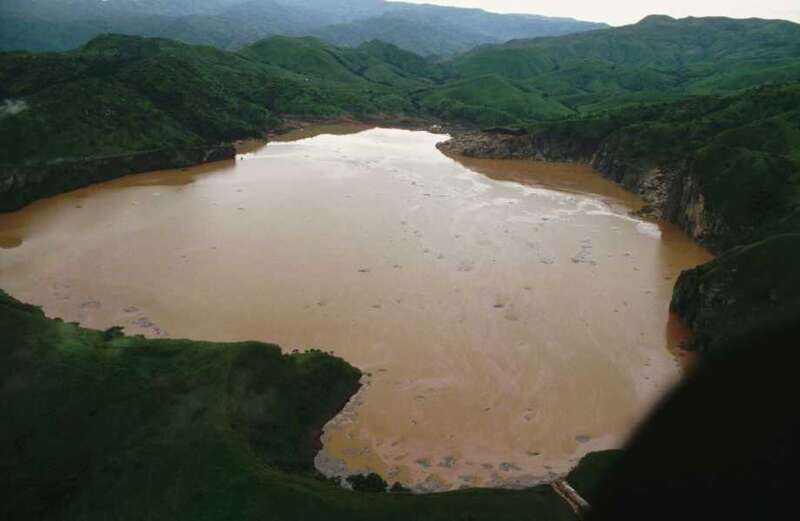A TRANQUIL lake in Cameroon turned blood red before it silently massacred every breathing being within 16 miles.
Lake Nyos erupted a toxic gas cloud which suffocated thousands of people and animals that lived nearby.




On 21 August 1986, a limnic eruption at the lake in northwestern Cameroon killed 1,746 people and 3,500 livestock.
Nothing foretold troubles on the night that Lake Nyos erupted.
The lake, set in the crater of a dormant volcano, emitted not lava or ash but instead a massive cloud of cool carbon dioxide gas.
 Blackpool earthquake: British Geological Survey measures 1.5 magnitude tremor – making cabinets shake
Blackpool earthquake: British Geological Survey measures 1.5 magnitude tremor – making cabinets shake
The eruption released about 100,000 to 300,000 tons of CO2 which rose up at nearly 62 miles per hour.
But being heavier than air, the toxic gas eventually settled to the ground and raced down the hills to nearby villages, killing everything on its way.
The next morning, over 1,700 people and 3,500 kettle were found deceased with no signs of struggle or violence.
The villages were eerily quiet, filled with dead silence uninterrupted even by insects.
Some survivors talked about sleeping for two days and waking up to dead bodies of their families strewn around them.
When they stumbled out of their houses, they could see their chicken laying around lifeless on the streets and their livestock dead in the fields.
FOUL STENCH
At the time, nobody could explain the nature of these terrifying and strange deaths.
Some speculated of "secret government experiments" but the real killer was soon revealed.
The rare volcanic phenomenon was responsible for the quick and silent massacre near Lake Nyos.
Witnesses say they only heard a distant explosion, others said they could smell a foul odour when it happened.
 Turkey earthquake sparks 100ft inferno as burst gas pipe sends flames into sky
Turkey earthquake sparks 100ft inferno as burst gas pipe sends flames into sky
But most people heard nothing and had no idea of what was to come.
One survivor, Joseph Nkwain from Subum, described what he experienced after he awoke from the gas: "I could not speak. I became unconscious.
"I could not open my mouth because then I smelled something terrible.
"I heard my daughter snoring in a terrible way, very abnormal."
Nkwain tried to reach his daughter's bed when he collapsed and fell.
He was passed out until the next morning when his friend came and knocked at his door.
"I opened the door. I wanted to speak, my breath would not come out.
"I went into my daughter's bed, thinking that she was still sleeping," the survivor recalled.
"My daughter was already dead."
Nkwan's trousers had red stains and he noticed "starchy mess" on his body.
He also had wounded arms with no recollection of how he got those wounds.
"I managed to go over to my neighbours' houses. They were all dead."
Nkwan decided to leave to join the rest of his family that lived in Wum, a town 18 miles from the lake.
He hopped on his motorbike with a friend whose father had died in the tragic incident.
"As I rode through Nyos I didn't see any sign of any living thing. (When I got to Wum), I was unable to walk, even to talk, my body was completely weak," Nkwan added.
GAS ATTACK
Many survivors were treated at the hospital in Yaounde, the country's capital.
Doctors believed the victims were poisoned by a mixture of gases including hydrogen and sulphur.
The common symptoms included burning pains in the eyes and nose, coughing and signs of asphyxiation.
The clinical studies showed that survivors and corpses had redness and large blisters on their bodies.
Though these injuries were thought to be burns from acidic gases, later they were believed to be pressure sores from long periods of immobility.
The explanation as to why Lake Nyos erupted lethal amounts of carbon dioxide have long been debated.
Days after the disaster, scientists arrived at the site to study the weird phenomenon that wiped out an entire population of one of the villages.
They found that carbon dioxide had built up under high pressure in Lake Nyos.
But what triggered the gas to be released still remains a mystery.
Most geologists believe it was a landslide but some suspect there was a small volcanic eruption on the bed of the lake.
Whatever the reason, the result was that the toxic gas burst out of the lake and poisoned those in its path.
The normal levels of CO2 is less than a tenth of one per cent but on that fateful day, it has reached over ten per cent.
Eyewitnesses described how the lake had turned a blood red colour while a sudden wind arose and whipped up huge waves.
The colour change was sparked by iron-rich water rising to the surface before being oxidised by the air.
Since the disastrous event, French scientists have implemented a degassing system to reduce the amount of carbon dioxide in the deadly lake and prevent future tragedies.
In 2001, they installed a pipe that runs from the bottom of Lake Nyos and allows gas to escape at a regular rate.
Two more pipes were added ten years later, and an alarm system was put in place to warn the villagers should the lake explode again.
There were only two recorded instances of limnic eruptions in history, and both took place in Cameroon.
Two years before the Lake Nyos disaster, a similar event killed 35 people at the lake Monoun, 60 miles south of Nyos.





































